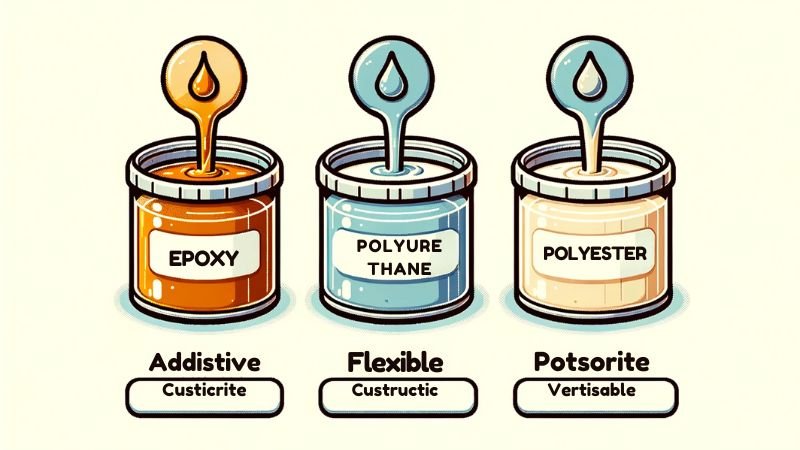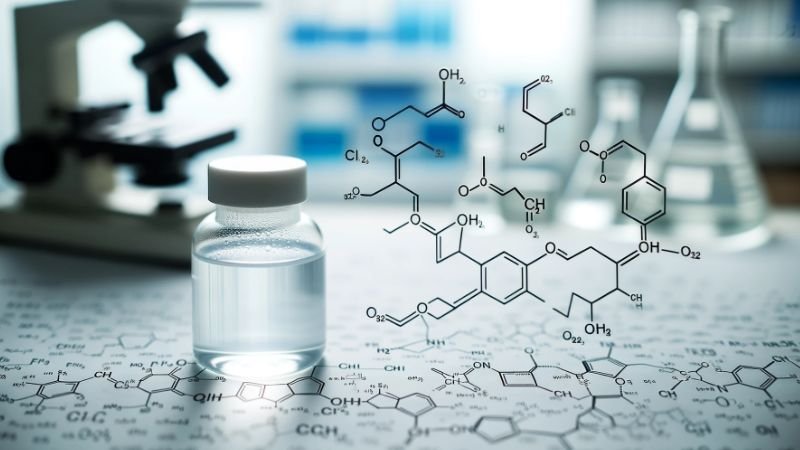Полиэстер смола шога семын рӱдӧ кӱ полимер-влак, тудын универсал да кумдан шарлыше приложений дене чапланен.
Полиэстер Смола могай?
Полиэстер смола, тудын рӱдыжӧ, полимер – шинчыр повторяющийся молекулярный единице. Но мо тудым ойыртемалтше тыгыде тӱняште полимер-влак?
Определений да базовый химий .
Полиэстер смола ненасыщенный синтетике смола-влак формироватлалтеш реакций дибазный органике кислота да полигидрический спирт. Тиде тыглай вязкость, шем тӱсан жидкость. Нунын химий ӧрыктарыше, молекул куштымашым ушен, кушто кислота да спирт-влак пырля толыныт, эфир ушымашым ышташ манын.

Вес смола дене таҥастарымаште .
Шуко уло гынат, нунын дене шкешотан смола, кажныже шкешотан шкешотан улмыж дене, полиэфирный смола шке вержым шке ойыртемалтше ойыртемже дене кылдалтын. Мутлан:
- Эпоксидный смола: Шке ӱлнӧ улшо клеитлымаш шкешотан да химий веществалан торешланыме дене палыме. Туге гынат, тудо тыглай полиэфир деч шергырак.
- Полиуретан смола: Предложений лывыргылык да кучылтмо приложенийыште кучылталтеш, кушто кугу абразивный торешланыше кӱлешан. Да тудын чулымлыкым вӱдыжгӧ годым эмлыме годым ограниченийым лийын кертеш.
Вашталтышым, полиэфирный смола чӱчкыдын тудын роскотлан эҥгекым ыштен, кучылташ куштылго, да тӱрлӧ приложенийлан келыштарыме.
Полиэстер смола-влакын типышт
Чыла полиэфир смола икгай огыл ышталтын. Химический умдо деч шога, ме нуным икмыняр типлан классифицироватлаш, кажныже шкешотан атрибутшо дене келыштарыме ойыртемалтше приложений.
Ортофталический смола (генеральный-целевой смола) .
Фталический ангидрид гыч лектын, тиде эн шарлыше тип полиэфирный смола пазарыште. Тиде тендан домкрат-чыла торгайыме – шот дене ак да универсал.
Свойство:
- Сай механике свойствыжым .
- Вӱдлан да тӱрлӧ химий веществалан торешланымыже .
Типичный приложений .:
- Кучылтмо стекловолокно ламинат ыштен лукмо, кузе тыгай ванна, кайык, да изи автомобиль ужаш.
Изофтолик Смола
Лӱмжым изофтал кислота гыч лектын, тиде смола шке ортофтальный иза-шольыжо ӱмбалне кугемдыме лектышым пуа.
Свойство:
- Ӱлыл вӱд ваштареш шогышо .
- Enhanced corrosion resistance against a range of chemicals
Типичный приложений .:
- Ideal for marine environments, such as boat hulls that need to withstand constant water exposure.
- Used in industrial applications where chemical resistance is a priority.
Dicyclopentadiene (DCPD) Resin
DCPD is a byproduct of naphtha cracking. When incorporated into polyester resin, it offers some intriguing benefits.
Свойство:
- Low shrinkage
- Improved toughness and flexibility
Типичный приложений .:
- Automotive parts, where a smooth finish and high impact resistance are paramount.
- Body panels of vehicles due to its high-quality surface finish capability.

Properties of Polyester Resin
To truly appreciate the versatility of polyester resin, one must dive into its intrinsic properties. These characteristics not only set it apart but also determine its suitability for various applications.
Механике собственность .
- Strength: Polyester resins exhibit commendable tensile, flexural, and compressive strength, making them ideal for structural applications.
- Flexibility: While not the most flexible of resins, they offer enough give to prevent brittleness in most of their applications.
- Hardness: Upon curing, polyester resins form a hard surface, which can be further reinforced with additives and fibers.
Chemical Resistance
- General: Polyester resins, especially isophthalic variants, resist a wide spectrum of chemicals, from weak acids to bases.
- Water Resistance: Ик амалже, нунын популярностьышт теҥыз кучылтмо, полиэфир смола сай вӱд торешланен ончыкта, поснак чын формулироватлыме годым.
Пеҥгыдылыкше да илыш-йӱлаже
- УФ-ын стабилыже: Эн ультрафиолетовый стабильный огыл гынат, полиэфирный смола ешартыш дене вашталташ лиеш, кужу жап чыташ манын, кужу кече лектын.
- Чия да шинчавӱд .: Нунын механике пеҥгыдылыкыштым шотыш налын, полиэфирный смола-влак кече еда кучылтмо строгостьым чытен, лектышыш шуаш кужу жаплан продукт.
Кучылташ куштылго да универсал .
- Куринг: Полиэстер смола-влакым пӧлем температур годым эмлаш лиеш, катализатор-влакым кучылтын, мутлан, МЭКП (Метил Этил Кетон Пероксид).
- Адгезия: Нуно тӱрлӧ ӱмбаллан сайын пижыт, кумда ӱмбал ямдылыме кӱлешлыкым кораҥдаш.
- Управлений: Their ability to be combined with fillers, pigments, and other additives makes them adaptable to a plethora of applications.

Key Applications
Polyester resin’s multifaceted properties render it indispensable across diverse industries. From marine vessels cruising the oceans to the very cars we drive, its presence is ubiquitous.
Marine Industry
- Boat Hulls: Thanks to its water and chemical resistance, polyester resin is the primary choice for crafting boat hulls, ensuring they remain impervious to the constant aquatic onslaught.
- Decking & Components: Beyond the hull, other boat parts like decks, masts, and interiors often employ polyester resin due to its durability and ease of maintenance.
Automotive
- Body Fillers: Кеч-кунам ӧрмалген, шпаклевка гай вещества кучылталтше, автомобильыште дент-влакым лывырге луктын? Тиде’ чӱчкыдын полиэфирный смола ден заполнитель-влакын мешакышт, тудын куштылгылыкшым да шлифоватлымашым куштылеммыж дене аклалтеш.
- Ламинат & Панель-влак: Шинча, лывырге тӱжвал шуко автомобиль шке лустерым полиэфирный смола дене инфузионный стекловолокно гыч ыштыме слой-влаклан парымже уло.
Конструкций
- Панель-влак & Предступлений: Зданий-влак, поснак коммерческий, полиэфирный смола негызеш панельым кучылт кертеш, эстетике да пеҥгыдылыкше.
- Ванныйыште фикс-влак: Пеҥгыде, но стильный ванна, раковина, да душ ларек, чӱчкыдын стекловолокно гыч ыштыме, нунын формо да функцийлан полиэфир смола ӱшанен.
Искусство & Ремесло
- Скульптур & Сӱретыште: Художник-влак чӱчкыдынак скульптурым ыштыме годым полиэфирный смола деке савырнат, тудын ӱпым да пытартышым акленыт.
- Ювелир ӱзгар: Смола ювелир тенденций ужын, ремесленник-влак встраивать объект да пигмент яндар полиэстер смола, ыштен ӧрыктарыше лаштык-влак.
Пайдаже да ситыдымашыже
Кеч-могай материал семынак, полиэфирный смола ӱстел деке конда, пайдам да ограниченийым мешак. Тидым пален налын кертеш, тудын йодмашыштыже информированный пунчалым лукмо йӧн дене виктарен кертеш.
Пайдаже
- Роскот-эффективность .: Ик эн тӱҥ амалже тудын кумдан кучылтмо, полиэфир смола сай балансым темлена доступен ак точко.
- Кучылтмо куштылго: Пӧлем температур да тура аралаш процедурым ыштен кертме дене, тудо’ пайдаланыше-влаклан келшыше, поснак тӱҥалше-влаклан.
- Келыштарымаш: Полиэстер смола’ тӱрлӧ ешартыш дене келшен толшо, заполнитель, да волокно тудым йӧным пуа, шуко приложений-конкретле йодмашым шукташ.
- Пырче: Its inherent strength and resistance to many environmental factors mean products made with polyester resin tend to have a long life.
- Good Adhesion: Its ability to bond well with many surfaces negates the need for complex surface preparations.
Disadvantages
- Brittleness: In comparison to some other resins, especially when not reinforced, polyester can be more prone to cracking under stress.
- UV Sensitivity: Prolonged exposure to sunlight can degrade polyester resin unless it’s modified with UV stabilizers.
- Lower Heat Resistance: Relative to materials like epoxy, polyester resin has a lower threshold for withstanding heat.
- Shrinkage: During the curing process, polyester resin can exhibit some shrinkage, which might be a concern in precision applications.
- Odor: Характеристикан ӱпшӧ годым эмлыме процесс лийын кертеш офф-тошто южо, поснак локтылалтше верыште.

Экологий эффект да ӱшанле .
Эра утларак да утларак рашемдыме экологий сознаний, экологий лапка материалым умылен, ме кече еда кучылтмо эн тӱҥ. Полиэстер смола, шуко отрасльыште инструментальный годым, экологий шотышто шонымашым нумалыт, тудо тӱткышым йодеш.
Экологий тургыжланымаш
- Биоразлагаемость .: Шуко синтетике полимер семынак, полиэфирный смола-влак йырым-йырысе пӱртӱсыштӧ куштылгын огыт локтылалт. Тиде кужу жаплан шӱкшакым луктеш, поснак продукций шке ӱмыржӧ мучаш марте шуэш.
- Производство лукмаш: Полиэстер смола ыштен лукмаш химий процесс-влакым ушештара, тудо загрязняющий веществам эфирыш да вӱдыш луктын кертеш.
- Волгалтарыме органике соединений-влак (ЛОС): Процесс годым, южо формулировко полиэфирный смола ЛОС луктын кертеш, тудо эҥер лавыртымашлан полша да локтылалтше верыште зияным ыштен кертеш.
Ошкыл-влак деке ӱшанле .
- Перерабатыватлыме инициативе .: Эффорт-влак полиэфирный смола гыч ыштыме продукцийым перерабатыватлаш тӱҥалыт, нуно полигонлаште огыт пытаре. Задаче-влак улыт гынат, технологийыште ончыко каяш сӧрымашым темлат.
- Био-негызеш ыштыме смола-влак: Шымлызе-влак шымлымаш смола гыч лектын, уэмдыме ресурс гыч альтернатива йӱла нефть негызеш полиэфир смола.
- Лӱдыкшӧ ВОС-ым иземдымаш .: Кызытсе формулировко да ешартыш цельым шынден, ЛОС-влакым лукмо процесс годым луктын, экологий да тазалык шотышто тургыжланымашым луштараш.
- Ответственный производствым .: Компаний-влак арулыкым ыштен лукмо йӧн-влакым илышыш пуртат, лукмашым иземдат, сырьём ӱшанле налме верлан ойыреныт.
Ончыкылык тенденций
Кузе ме писын вияҥше тӱня гоч ориентироватлаш, полиэфир смола дене пырля путешествийыш ямде, келыштарыме да инноваций. Теве’ шинчаончалтышыже, мом горизонт куча тиде универсал материал.
Технологий ончыко каяш .
- Нанотехнологий: Полиэстер смола дене нано-заполнитель-влакым пуртымо тудын койышыжым раш кугемден кертеш, механике пеҥгыдылык гыч ультрафиолетовый торешланымаш.
- Ушан материал: Шоналтыза, кайык корпусым, шкевуя паремеш изирак тыртыш але автомобиль панельым, тӱс дене вашталташ температур. Интеграций полиэфир смола дене ушан ешартыш ыштен кертеш тиде чынлык.
Экологий фокус .
- Грин Полиэстер: The push towards eco-friendly alternatives will lead to more widespread adoption of bio-based polyester resins, decreasing dependency on fossil fuels.
- Circular Economy: Efforts will intensify to create a closed-loop system for polyester resin products, promoting reuse and recycling over disposal.
Broader Application Scope
- Medical: With biocompatibility advancements, we might see polyester resins in medical applications, from prosthetics to medical equipment housing.
- Space and Aviation: As research progresses, polyester resin composites might find applications in the demanding realms of aerospace and space exploration.
Collaborative Research
- Industry-Academia Partnerships: Промышленность да академический учреждений-влак коклаште сотрудничество шымлымашым писынрак ыштен, ончыко инноваций полиэфирный смола приложений да формулировко.
Мучашмут
Полиэстер смола, материал, тудо шке гыч бесшовный ургымо тӱрлӧ отрасльыште ткань, айдеме изобретательность да келыштарыме нерген танык семын шога. Тудын негызше химий гыч тӱҥалын, кумдаҥдыме приложенийже марте, тудын историйже универсал да эволюций гыч иктыже.
Тудо жапыште тудын деч посна огыл, поснак экологий ӱшанле сферыште, ончыкылык волгыдо коеш. Технологий ончыко каяш горизонт, эко-сознательный практикым кугемдыме акцент дене пырля, полиэфирный смола йӧн дене вияҥеш, умбакыже тудын пайдалыкше дене келыштарыме годым тӱнямбал ӱшанле цель дене.





